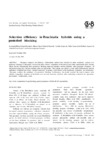Please use this identifier to cite or link to this item:
http://www.alice.cnptia.embrapa.br/alice/handle/doc/314035| Title: | Selection efficiency in Brachiaria hybrids using a posteriori blocking. |
| Authors: | RESENDE, R. M. S.  RESENDE, M. D. V. de   VALLE, C. B. do   JANK, L.   TORRES JÚNIOR, R. A. de A.   CANÇADO, L. J.   |
| Affiliation: | Rosangela Maria Simeão Resende, Embrapa Gado de Corte; Marcos Deon Vilela de Resende, Embrapa Florestas; Cacilda Borges do Valle, Embrapa Gado de Corte; Liana Jank, Embrapa Gado de Corte; Roberto Augusto de Almeida Torres Júnior, Embrapa Gado de Corte; Letícia Jungmann Cançado, Embrapa Gado de Corte. |
| Date Issued: | 2007 |
| Citation: | Crop Breeding and Applied Biotechnology, Viçosa, MG, v. 7, p. 296-303, 2007. |
| Description: | This paper compares the efficiency of Brachiaria hybrid clone selection by either traditional analysis or a posteriori blocking, to adequately consider the effect oflower competition in the border rows ofthe experimental plots (border effect). Results demonstrated that a posteriori blocking improved selection and the reliability ofthe genotypic evaluation. Of the ten best clones. four did not coincide in the two approaches. The ranking was altered as well, which demonstrated that the indication of the five best clones. selected to proceed to pasture trials based on the traditional evaluation, was misleading. This paper confirms the usefulness of a posteriori blocking. Furthermore, the results revealed lhe need to impose more effective competition on plants in the border rows to avoid erroneous selection when conducting evaluations for agronomic performance in Brachiaria trials. |
| Thesagro: | Brachiaria Gramínea Parâmetro Genético |
| Keywords: | Competição REML-BLUP Repetibilidade |
| Type of Material: | Artigo de periódico |
| Access: | openAccess |
| Appears in Collections: | Artigo em periódico indexado (CNPF)  |
Files in This Item:
| File | Description | Size | Format | |
|---|---|---|---|---|
| SelectionefficiencyinBrachiaria.pdf | 55,79 kB | Adobe PDF |  View/Open |









